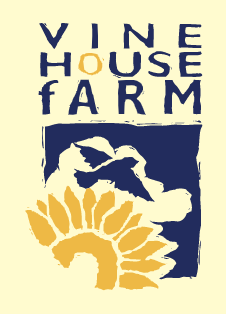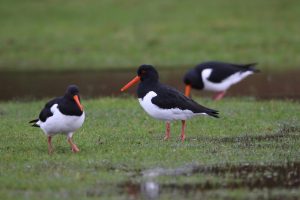
March has been a warm month, the mean temperature being 8.2°C. There have only been three warmer Marchs in the last 50 years. The coldest March I have recorded was in 2013, when the average temperature was only 2.7°C! All the rain came in the first half of March, 48mm of it, which is slightly wetter than average.

The last two weeks of the month have allowed us to get on with our spring drilling, we drilled the last of the spring barley, all the peas, beans and the sugar beet. It is the first time we have had all the sugar beet drilled in March for many years. If the weather keeps fine, we will drill the canary seed during the first week in April but will have to wait a few weeks before we drill the millet and the sunflowers, the soil needs to warm up a bit before they will germinate.
We will be starting planting potatoes during the first week in April. We still have about 1,000 tonnes of last year’s potatoes in store, the ones for MacDonalds are not due to go until June, they are on a fixed price contract. The ones destined to go into supermarkets are not on contract and at present prices are £50/tonne above their contract prices so we will be making good money on those. This will off-set last year’s price, when they were £70 below the contract price. The firms that pack the potatoes offer us contracts, but the price is not very good so we prefer to take the market price. Some years we can make good money on potatoes, but if there is a surplus of potatoes, like with the 2017 crop, we can also make a loss.
I frequently talk about how direct drilling attracts wildlife. All the fields where we have direct drilled oil radish, and the next spring drilled spring barley or peas, have Lapwings displaying on them and Skylarks are singing above them also. We have four fields that have been direct drilled and seven more fields that have Lapwings nesting on them, totalling about 40 pairs.
It is seldom that a new idea in farming increases wildlife, however this one seems to have doubled Skylark numbers in one season. The only other time I can recollect this happening is when we started spraying rape to prepare it for harvest, instead of cutting it. 50% of the Reed Buntings were still nesting when rape was cut and no nests survived the cutting, but all nests survived the spraying. Farmers gradually converted to spraying the rape, but only because it made agricultural sense to do so.
Whilst feeding the birds in the winter is an easy job, feeding the birds in the summer is not so easy. We have to have a varied habitat to provide a variety of insects and that does not happen on our farms, or in our gardens, unless we make an effort all through the year.
A vegetable garden would have been a varied habitat, but very few people grow vegetables now and our gardens in general are far less diverse than they used to be. All the crops on our farms would have had weeds in them making a diverse habitat but now most of our crops don’t contain weeds.
At this time of year, we tend to those areas that we are growing for insects, only taking out weeds that we don’t want, such as cleavers thistles and docks. Thistles are good for wildlife, but if their seed blows on to our fields, it gets very expensive as we have to treat a whole field to control the thistles.


Reed Buntings and Yellowhammers seem to make full use of our pheasant feeders, which are scattered all round the farm. We make sure they remain full of wheat until the end of May, or early June, when natural food becomes more available.
Two hundred Golden Plover were feeding on one field at Chestnut farm for at least 10 days, on their way North. This field was not ploughed, so the stubble remains which gives the Golden Plovers good camouflage. Six pairs of Lapwings are also on that field and one morning I watched a Peregrine arrive – the Lapwings immediately rose up and stayed up, well above the Peregrine. The Peregrine swoops down on its prey from a height, so when the Lapwings were above the Peregrine they were safe.
Our wetland in Baston Fen, which ajoins Baston Fen Nature reserve, had up to 1,000 Wigeon grazing on it during early March but they have now all gone. There are still 30 Teal who will soon disappear North to breed. That has left about eight pairs of Mallard, two or three pairs of Shoveler, Gadwall, Coot, Redshank and Oystercatchers. Also 18 pairs of Lapwing and 10 pairs of Grey Lag Geese, all of which I am expecting to breed.
We have been feeding Blackbirds, Pied Wagtails, Robins and Wrens with live mealworms outside our farm shop. If they run out, a Wren comes to the door of the shop and waits for attention to get a refill.
Mealworms are also providing the main source of interest in the garden, we have two pairs of Robins that have young in the nest and are taking mealworms. Robins are highly territorial and everything is calm until two Robins appear at the feeder together. I haven’t yet seen them have a fight, but they face each other, swaying from side to side until one of them turns away. The other one pops in the cage, collects two or three mealworms and disappears as fast as he can.
A Blackbird also comes round the feeder, cocking his head on one side rather puzzled as to why he can’t get in to the mealworms. A Chaffinch also a takes a few mealworms, he learnt how to get in last year. Studies have shown that if you feed live mealworms in your garden you will rear 60% more birds. I get more enjoyment from feeding live mealworms than any other bird food.
We have a garden pond, which was created about 30 years ago to enable Reed Warblers to breed. It was successful, but the reeds dominated the pond. We replanted it with native plants, which makes enough vegetation for a Moorhen to hide its nest in late May and even then the eggs would sometimes disappear. Four years ago we would’ve had about 15 Moorhens wintering in the paddock by the farm house. They lived on grain left by the free range cockerels and wheat from the grain dryer. Their numbers have declined, until there were only six with us over winter. I didn’t want another species to disappear so this year we have had a small house, or a big nest box made, placed on a pallet and floated out in the pond. Within two weeks the Moorhen were building a nest there, so I am hoping to increase our wintering numbers.
TALKS & EVENTS
We have the following Farm Walks this summer:
18th May & 15th June: See and hear the birds around the farm
6th July: Centred around the flower meadows
3rd, 10th & 11th August: include a visit to the sunflower field



